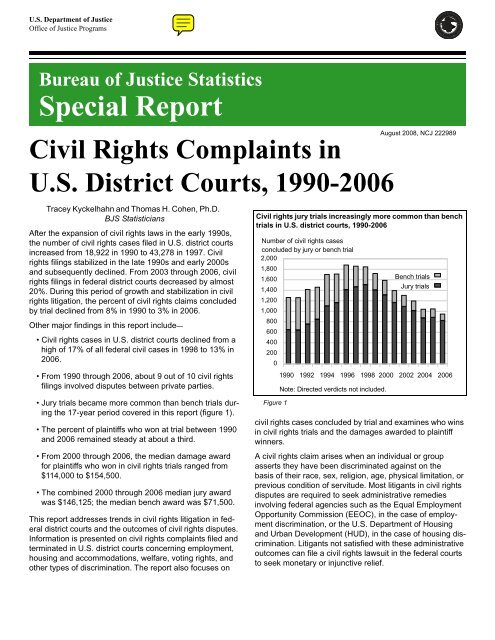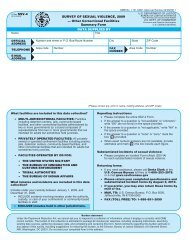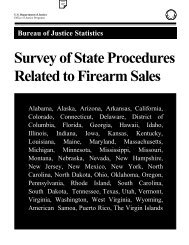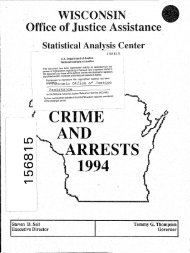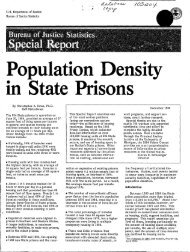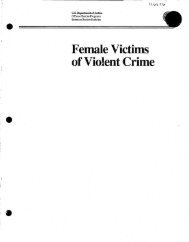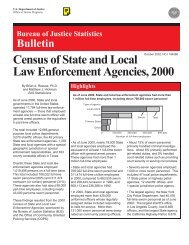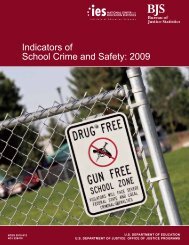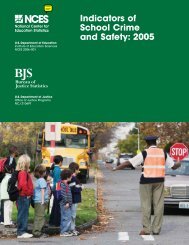Civil Rights Complaints in US District Courts, 1990-2006 - Bureau of ...
Civil Rights Complaints in US District Courts, 1990-2006 - Bureau of ...
Civil Rights Complaints in US District Courts, 1990-2006 - Bureau of ...
You also want an ePaper? Increase the reach of your titles
YUMPU automatically turns print PDFs into web optimized ePapers that Google loves.
Percent <strong>of</strong> civil rights cases concluded by trialdecl<strong>in</strong>ed from 8% <strong>in</strong> <strong>1990</strong> to 3% <strong>in</strong> <strong>2006</strong>Of the 17,985 civil rights compla<strong>in</strong>ts disposed <strong>in</strong> <strong>1990</strong>, 8%were term<strong>in</strong>ated by trial, while <strong>in</strong> <strong>2006</strong>, 3% <strong>of</strong> the 33,108civil rights claims concluded <strong>in</strong> federal courts ended <strong>in</strong> atrial (table 4). Other cases concluded by a judgmentrema<strong>in</strong>ed steady dur<strong>in</strong>g this period at about a quarter <strong>of</strong>term<strong>in</strong>ations. This category <strong>of</strong> term<strong>in</strong>ations <strong>in</strong>cluded judgmentby defaults, consent, motions before trial, and judgmentsthrough formal arbitration procedures adopted bythe court.The percentage <strong>of</strong> civil rights cases dismissed from U.S.district courts <strong>in</strong>creased from 66% <strong>in</strong> <strong>1990</strong> to 75% <strong>in</strong> 2003,and decreased slightly to 72% <strong>in</strong> <strong>2006</strong>. <strong>Civil</strong> rights dismissalsfollowed the same trend as out <strong>of</strong> court settlements andvoluntary dismissals. Out <strong>of</strong> court settlements rose from31% to 39% <strong>of</strong> all civil rights dispositions between <strong>1990</strong>and 2003. Voluntary dismissals <strong>in</strong>creased from 8% to 13%<strong>of</strong> all civil rights dispositions between <strong>1990</strong> to 2003. S<strong>in</strong>ce2003, both the settlement and voluntary disposition categorieshave decl<strong>in</strong>ed slightly. Settlements accounted for 37%and voluntary dismissals accounted for 11% <strong>of</strong> civil rightsdispositions by <strong>2006</strong>.The proportion <strong>of</strong> civil rights dismissals which occurred dueto lack <strong>of</strong> jurisdiction decl<strong>in</strong>ed from 8% <strong>in</strong> <strong>1990</strong> to 2% <strong>in</strong><strong>2006</strong>. From <strong>1990</strong> to <strong>2006</strong>, civil rights cases dismissedbecause <strong>of</strong> want <strong>of</strong> prosecution rema<strong>in</strong>ed at about 4%.In <strong>1990</strong>, welfare civil rights cases (3%) were the least likelyto go to trial while employment discrim<strong>in</strong>ation cases (9%)were the most likely to reach trial (table 5). In <strong>2006</strong> the percent<strong>of</strong> civil rights cases end<strong>in</strong>g <strong>in</strong> trial exhibited a smallerrange across all categories, vary<strong>in</strong>g between two and threepercent.Table 3. <strong>Civil</strong> rights compla<strong>in</strong>ts with the U.S. government <strong>in</strong>volved as pla<strong>in</strong>tiff or defendant filed <strong>in</strong> U.S.district courts, by type, <strong>1990</strong>-<strong>2006</strong>U.S. government as pla<strong>in</strong>tiffU.S. government as defendantYear Total Employment Vot<strong>in</strong>g Hous<strong>in</strong>g Welfare Other* Total Employment Vot<strong>in</strong>g Hous<strong>in</strong>g Welfare Other*<strong>1990</strong> 747 601 10 37 5 94 1,736 876 6 20 17 8171995 668 410 8 115 -- 135 2,358 1,275 12 38 13 1,0202000 633 425 16 50 -- 142 2,387 1,362 10 32 7 9762001 710 516 7 55 1 131 2,322 1,270 15 43 7 9872002 649 464 8 55 1 121 2,380 1,266 17 27 9 1,0612003 599 445 3 34 -- 117 2,315 1,294 5 20 2 9942004 603 435 12 35 1 120 2,262 1,271 9 18 6 9582005 534 420 8 42 -- 64 2,172 1,166 15 22 6 963<strong>2006</strong> 499 373 16 32 -- 78 1,961 938 12 18 7 986*Types <strong>of</strong> civil rights cases with<strong>in</strong> the "other" category cannot be dist<strong>in</strong>guished.-- No cases recorded.Source: Annual Report <strong>of</strong> the Director. Wash<strong>in</strong>gton, D.C.: Adm<strong>in</strong>istrative Office <strong>of</strong> the U.S. <strong>Courts</strong> (table C-2).Table 4. <strong>Civil</strong> rights cases concluded <strong>in</strong> U.S. district courts, by disposition, <strong>1990</strong>-<strong>2006</strong>Percent <strong>of</strong> cases disposedYearNumber <strong>of</strong> compla<strong>in</strong>tsdisposed a Total Settled VoluntaryDismissedLack <strong>of</strong>jurisdictionJudgmentWant <strong>of</strong>prosecution Other Total Trial b Other c<strong>1990</strong> 17,985 66.2% 30.7% 8.1% 8.3% 5.0% 14.1% 33.8% 7.6% 26.2%1995 30,175 69.4 33.4 11.8 2.0 4.1 18.1 30.6 6.0 24.62000 39,941 72.3 37.6 11.9 1.7 4.1 17.0 27.7 4.1 23.62001 38,612 73.9 38.9 12.2 1.8 4.0 17.0 26.1 3.8 22.32002 38,551 74.2 37.8 12.7 1.8 4.0 17.8 25.8 3.6 22.32003 37,624 74.7 38.5 12.8 1.9 4.0 17.5 25.3 3.4 22.02004 37,407 73.8 37.6 12.0 1.8 4.0 18.5 26.2 2.9 23.32005 36,929 73.6 38.1 11.8 1.7 4.1 17.9 26.4 3.0 23.5<strong>2006</strong> 33,108 72.0 37.0 11.4 1.7 4.4 17.6 28.0 3.0 25.0Note: Does not <strong>in</strong>clude prisoner petitions. Percentages may not sum to total due to round<strong>in</strong>g.a Excludes transfers, remands, and statistical closures.b Trial <strong>in</strong>cludes cases disposed <strong>of</strong> by jury trial, bench trial, and directed verdict. In some cases, the parties may have settled beforethe completion <strong>of</strong> the trial.c Includes judgments by default, consent, a motion before trial, judgment <strong>of</strong> arbitrator or by some other f<strong>in</strong>al judgment method.Source: Adm<strong>in</strong>istrative Office <strong>of</strong> the U.S. <strong>Courts</strong>, <strong>Civil</strong> Master File.<strong>Civil</strong> <strong>Rights</strong> <strong>Compla<strong>in</strong>ts</strong> <strong>in</strong> U.S. <strong>District</strong> <strong>Courts</strong>, <strong>1990</strong>-<strong>2006</strong> 5
Jury trials <strong>in</strong>creased as a percent <strong>of</strong> all trialsA jury trial is held before a jury—a selected body <strong>of</strong> personssworn to give their verdict accord<strong>in</strong>g to the evidence—andpresided over by a judge. A bench trial is held <strong>in</strong> theabsence <strong>of</strong> a jury and decided by a judge.Jury and bench trials each accounted for about half <strong>of</strong> allcivil rights trials concluded <strong>in</strong> federal district courts <strong>in</strong> <strong>1990</strong>(figure 1). By <strong>2006</strong>, jury trials accounted for 87% <strong>of</strong> civilrights trials. The growth <strong>of</strong> jury trials can be partially attributedto Title VII <strong>of</strong> the <strong>Civil</strong> <strong>Rights</strong> Act <strong>of</strong> 1991, whichallowed jury trials when a pla<strong>in</strong>tiff sought punitive or compensatorydamages <strong>in</strong> employment discrim<strong>in</strong>ation cases.The percentage <strong>of</strong> employment discrim<strong>in</strong>ation trials <strong>in</strong>volv<strong>in</strong>ga jury <strong>in</strong>creased from 40% <strong>in</strong> <strong>1990</strong> to 86% <strong>in</strong> <strong>2006</strong> (notshown <strong>in</strong> a table). The percentage <strong>of</strong> other civil rights casesdisposed <strong>of</strong> by jury trial <strong>in</strong>creased from 66% <strong>in</strong> <strong>1990</strong> to 86%<strong>in</strong> <strong>2006</strong>.On average, pla<strong>in</strong>tiffs won a third <strong>of</strong> civil rights casesfrom <strong>1990</strong> to <strong>2006</strong>; median damage awards rangedfrom $114,000 to $154,500While the percent <strong>of</strong> civil rights cases term<strong>in</strong>ated by trialdecl<strong>in</strong>ed, about a third <strong>of</strong> pla<strong>in</strong>tiffs won their case at trialfrom <strong>1990</strong> to <strong>2006</strong> (table 6). The percent <strong>of</strong> pla<strong>in</strong>tiff w<strong>in</strong>nerswho received monetary damages decl<strong>in</strong>ed from 83% <strong>in</strong><strong>1990</strong> to 79% <strong>in</strong> <strong>2006</strong>.The estimated median damages awarded to pla<strong>in</strong>tiffsshowed no discernible pattern dur<strong>in</strong>g the period covered bythis report. S<strong>in</strong>ce <strong>1990</strong> the median damage awards haveranged from $114,000 <strong>in</strong> 2001 to $154,500 <strong>in</strong> 2005. In <strong>2006</strong>the median damages awarded to pla<strong>in</strong>tiffs prevail<strong>in</strong>g <strong>in</strong> civilrights trials was $150,000.<strong>Civil</strong> rights compla<strong>in</strong>ts brought under Title VII <strong>of</strong> the <strong>Civil</strong><strong>Rights</strong> Act <strong>of</strong> 1964 or the Americans with Disabilities Act <strong>of</strong><strong>1990</strong> typically <strong>in</strong>volve a compensatory award for economicdamages. Damages may <strong>in</strong>clude losses associated withback pay, <strong>in</strong>terest on back pay, lost benefits, attorney fees,some litigation costs, or other f<strong>in</strong>ancial losses that the courtdeems appropriate as a result <strong>of</strong> the defendant’s conduct.The <strong>Civil</strong> <strong>Rights</strong> Act <strong>of</strong> 1991 extended the type <strong>of</strong> damagesthat could be sought by pla<strong>in</strong>tiffs by allow<strong>in</strong>g claims for noneconomiccompensatory damages and punitive damages.Non-economic compensatory damages reimburse thepla<strong>in</strong>tiff for losses such as emotional pa<strong>in</strong>, suffer<strong>in</strong>g, <strong>in</strong>convenience,mental anguish, future monetary losses, as wellas loss <strong>of</strong> enjoyment <strong>of</strong> life. Punitive damages are <strong>in</strong>tendedto punish a defendant who acted with recklessness, malice,or deceit, and can be awarded <strong>in</strong> addition to compensatorydamages.The <strong>Civil</strong> <strong>Rights</strong> Act <strong>of</strong> 1991 placed a cap on the totalamount <strong>of</strong> compensatory and punitive damages that can beawarded, based on the size <strong>of</strong> the employer. The cap onawards does not apply to compla<strong>in</strong>ts <strong>of</strong> ethnic or racialdiscrim<strong>in</strong>ation.Award amounts <strong>in</strong>clude both compensatory and punitivedamages. For this report, the types <strong>of</strong> award amountscannot be dist<strong>in</strong>guished <strong>in</strong> the data. Monetary <strong>in</strong>formationpresented <strong>in</strong> this report is for civil rights cases <strong>in</strong> whichdamages were awarded. Excluded from this analysis werecivil rights compla<strong>in</strong>ts <strong>in</strong> which only court costs and/or attorneysfees were awarded.Table 5. Disposition <strong>of</strong> civil rights compla<strong>in</strong>ts concludedby trial by case type, <strong>in</strong> U.S. district courts, <strong>1990</strong> and <strong>2006</strong><strong>1990</strong> <strong>2006</strong>Case typeNumber <strong>of</strong>compla<strong>in</strong>tsdisposedPercentconcludedby trial*Number <strong>of</strong>compla<strong>in</strong>tsdisposedPercentconcludedby trial*Employment 8,206 8.7% 15,950 3.2%Hous<strong>in</strong>g 290 6.6 718 2.2Vot<strong>in</strong>g 125 5.6 118 2.5Welfare 120 3.3 41 2.4Other 9,244 6.8 16,281 2.8Source: Adm<strong>in</strong>istrative Office <strong>of</strong> the U.S. <strong>Courts</strong>, <strong>Civil</strong> Master File.* Includes jury trials, bench trials, and directed verdicts.Table 6. Pla<strong>in</strong>tiff w<strong>in</strong>ners and award amounts <strong>in</strong> civilrights compla<strong>in</strong>ts concluded by trial <strong>in</strong> U.S. district courts,<strong>1990</strong>-<strong>2006</strong>Monetary awardsYearPercentNumber <strong>of</strong> cases pla<strong>in</strong>tiffterm<strong>in</strong>ated by trial a w<strong>in</strong>ners bPercent <strong>of</strong> pla<strong>in</strong>tiffw<strong>in</strong>ners receiv<strong>in</strong>gmonetary awardsEstimatedmedianawards b<strong>1990</strong> 1,321 29.0% 82.8% ...1995 1,727 27.2 81.5 $128,0002000 1,600 34.1 76.3 152,1002001 1,411 35.4 79.2 114,0002002 1,314 32.3 76.7 120,4002003 1,183 31.0 76.0 129,2502004 951 30.8 76.8 128,4002005 830 31.9 73.6 154,500<strong>2006</strong> 717 30.8 78.7 150,000... Not reported for the year <strong>1990</strong>.a Includes jury trials, bench trials, and directed verdicts.b <strong>Civil</strong> rights trials <strong>in</strong> which both the pla<strong>in</strong>tiff and the defendant wonwere excluded from the pla<strong>in</strong>tiff w<strong>in</strong>ner and award calculation. Awardsadjusted for <strong>in</strong>flation to <strong>2006</strong> dollars.Source: Adm<strong>in</strong>istrative Office <strong>of</strong> the U.S. <strong>Courts</strong>, <strong>Civil</strong> Master File.6 <strong>Civil</strong> <strong>Rights</strong> <strong>Compla<strong>in</strong>ts</strong> <strong>in</strong> U.S. <strong>District</strong> <strong>Courts</strong>, <strong>1990</strong>-<strong>2006</strong>
Jury awards higher than bench awardsA comparison <strong>of</strong> civil rights bench and jury trials necessitatedcomb<strong>in</strong><strong>in</strong>g trial data for the years 2000 through <strong>2006</strong>because <strong>of</strong> the limited number <strong>of</strong> bench trials concludeddur<strong>in</strong>g this time period. The rate <strong>in</strong> which pla<strong>in</strong>tiffs prevailedat trial did not differ appreciably between jury and bench trials.Pla<strong>in</strong>tiffs won <strong>in</strong> about a third <strong>of</strong> trials litigated beforeeither a jury or judge (table 7). Bench trials awarded monetarydamages to 59% <strong>of</strong> pla<strong>in</strong>tiff w<strong>in</strong>ners and jury trialsawarded monetary damages to 81% <strong>of</strong> pla<strong>in</strong>tiff w<strong>in</strong>nersfrom 2000 to <strong>2006</strong>.Cases disposed <strong>of</strong> by jury trial had a median award <strong>of</strong>$146,125. In comparison, cases disposed <strong>of</strong> by bench trialhad a median award <strong>of</strong> $71,500. The 25th percentile forjury trials was $39,925 and the 75th percentile was$380,188. For bench trials, the 25th percentile was$17,880 and the 75th percentile was $292,500 (percentiledata not shown <strong>in</strong> table).Table 7. Pla<strong>in</strong>tiff w<strong>in</strong>ners and median awards for civil rightscases concluded by trial or case type <strong>in</strong> U.S. district courts,2000-<strong>2006</strong>Trial orcase typeNumber <strong>of</strong> Percentcases term<strong>in</strong>atedby trial a w<strong>in</strong>nerspla<strong>in</strong>tiffbMonetary awardsPercent <strong>of</strong> pla<strong>in</strong>tiffw<strong>in</strong>ners receiv<strong>in</strong>gmonetary awardsMedianawards bTrial typeJury 5,760 33.9% 80.7% $146,125Bench 1,218 33.3 59.0 71,500Case type cEmployment 3,809 36.7% 80.9% $158,460Hous<strong>in</strong>g 115 42.6 73.5 ...Other 3,013 29.7 71.6 100,000Note: <strong>Civil</strong> rights trial data comb<strong>in</strong>e the years 2000 through <strong>2006</strong>.a Includes jury trials, bench trials, and directed verdicts.b <strong>Civil</strong> rights trials <strong>in</strong> which both the pla<strong>in</strong>tiff and the defendant wonwere excluded from the pla<strong>in</strong>tiff w<strong>in</strong>ner and award calculation. Awardsadjusted for <strong>in</strong>flation to <strong>2006</strong> dollars.c Vot<strong>in</strong>g rights and welfare cases were too few to provide reliable data....Too few cases to calculate median award.Source: Adm<strong>in</strong>istrative Office <strong>of</strong> the U.S. <strong>Courts</strong>, <strong>Civil</strong> Master File.Employment discrim<strong>in</strong>ation pla<strong>in</strong>tiff w<strong>in</strong>ners morelikely to receive a monetary awardIn all civil rights trials concluded between 2000 and <strong>2006</strong>,employment discrim<strong>in</strong>ation pla<strong>in</strong>tiff w<strong>in</strong>ners (81%) weremost likely to receive a monetary award, followed by hous<strong>in</strong>gcases (74%), and other civil rights cases (72%).Employment discrim<strong>in</strong>ation cases received a medianaward <strong>of</strong> $158,460 for cases concluded by trial between2000 and <strong>2006</strong>. The 25th percentile for employment discrim<strong>in</strong>ationcases was $52,065 and the 75th percentile was$374,265 (percentile data not shown <strong>in</strong> table). The mediandamage award for civil rights trials <strong>in</strong> the "other civil rights"category was $100,000. For other civil rights cases, the25th percentile was $21,400 and the 75th percentile was$351,000.Case process<strong>in</strong>g time constant between <strong>1990</strong> and <strong>2006</strong>The median number <strong>of</strong> months from fil<strong>in</strong>g to disposition forcivil rights cases term<strong>in</strong>ated <strong>in</strong> federal district courts variedslightly between 9 and 11 months from <strong>1990</strong> to <strong>2006</strong> (table8). Employment discrim<strong>in</strong>ation cases generally had thelongest median case process<strong>in</strong>g time, vary<strong>in</strong>g between 11and 13 months (not shown <strong>in</strong> table).Table 8. Number <strong>of</strong> months from fil<strong>in</strong>g <strong>of</strong> compla<strong>in</strong>t todisposition among civil rights cases concluded <strong>in</strong> U.S.district courts, <strong>1990</strong>-<strong>2006</strong>Year Number disposedMedianMonthsMean<strong>1990</strong> 17,985 11.0 15.11995 30,175 9.8 12.62000 39,941 10.9 13.42001 38,612 10.6 13.02002 38,551 10.6 13.02003 37,624 10.6 13.32004 37,407 10.5 13.12005 36,929 10.7 13.2<strong>2006</strong> 33,108 11.0 13.6Source: Adm<strong>in</strong>istrative Office <strong>of</strong> the U.S. <strong>Courts</strong>, <strong>Civil</strong> Master File.<strong>Civil</strong> <strong>Rights</strong> <strong>Compla<strong>in</strong>ts</strong> <strong>in</strong> U.S. <strong>District</strong> <strong>Courts</strong>, <strong>1990</strong>-<strong>2006</strong> 7
Prisoner petitions <strong>in</strong> state and federal courts, <strong>1990</strong>-<strong>2006</strong>Various legislation and U.S. Supreme Court caseshave allowed state and federal <strong>in</strong>mates to sue forviolations <strong>of</strong> certa<strong>in</strong> constitutional rights.• In 1941, prisoners were permitted to file claims aga<strong>in</strong>ststate <strong>of</strong>ficials for violations <strong>of</strong> constitutional rights, <strong>in</strong>clud<strong>in</strong>gthe right to religious freedom, freedom <strong>of</strong> speech andassociation, due process, racial discrim<strong>in</strong>ation, and crueland unusual punishment. (Ex parte Hull, 312 U.S. 546(1941))• The U.S. Supreme Court granted <strong>in</strong>mates the right tobr<strong>in</strong>g lawsuits aga<strong>in</strong>st federal <strong>of</strong>ficials who violate theirconstitutional rights <strong>in</strong> 1963. (United States v. Muniz,374 U.S. 150 (1963))Follow<strong>in</strong>g the passage <strong>of</strong> the Prison Litigation ReformAct <strong>of</strong> 1996, which restricted the rights <strong>of</strong> <strong>in</strong>mates tosue <strong>in</strong> federal court, compla<strong>in</strong>ts filed by federal (20%)and state (31%) <strong>in</strong>mates decl<strong>in</strong>ed <strong>in</strong> 1997.From 1999 to <strong>2006</strong>, the number <strong>of</strong> civil rights prisonpetitions filed <strong>in</strong> U.S. district courts stabilized at about24,500 cases filed on average per year. Prisonpetitions <strong>in</strong>volv<strong>in</strong>g state <strong>in</strong>mates decl<strong>in</strong>ed by 7% from24,732 fil<strong>in</strong>gs <strong>in</strong> 1999 to 23,122 fil<strong>in</strong>gs <strong>in</strong> <strong>2006</strong>. Incomparison, federal <strong>in</strong>mate prison petitions <strong>in</strong>creasedfrom 962 fil<strong>in</strong>gs <strong>in</strong> 1999 to 1,334 fil<strong>in</strong>gs <strong>in</strong> 2004 anddecl<strong>in</strong>ed to 1,116 fil<strong>in</strong>gs by <strong>2006</strong>.From <strong>1990</strong> to 1996, prisoner petitions by federal<strong>in</strong>mates varied from about 900 to 1,200, with a high <strong>of</strong>1,219 <strong>in</strong> 1996. Petitions from state <strong>in</strong>mates <strong>in</strong>creasedfrom 24,843 to 39,996. Total fil<strong>in</strong>gs showed a steady<strong>in</strong>crease from 25,992 <strong>in</strong> <strong>1990</strong> to 41,215 <strong>in</strong> 1996.State prison petitions decl<strong>in</strong>ed after the Prison LitigationReform Act <strong>of</strong> 1996Number <strong>of</strong> prisoner petitions filed <strong>in</strong> U.S. district courts45,00040,000Federal prisoner petitions filed <strong>in</strong> U.S. district courtsranged from a low <strong>of</strong> 910 <strong>in</strong> 1992 to a high <strong>of</strong> 1,334 <strong>in</strong> 2004Number <strong>of</strong> federal prisoner petitions filed <strong>in</strong> U.S. district courts1,6001,40035,0001,20030,00025,00020,00015,000State<strong>in</strong>matesAll petitions1,000800600Federal <strong>in</strong>mate petitions10,0004005,000Figure 50<strong>1990</strong> 1992 1994 1996 1998 2000 2002 2004 <strong>2006</strong>Note: Includes prisoner petitions <strong>in</strong>volv<strong>in</strong>g civil rights andprison condition claims.2000<strong>1990</strong> 1992 1994 1996 1998 2000 2002 2004 <strong>2006</strong>Note: Includes prisoner petitions <strong>in</strong>volv<strong>in</strong>g civil rights andprison condition claims.Figure 68 <strong>Civil</strong> <strong>Rights</strong> <strong>Compla<strong>in</strong>ts</strong> <strong>in</strong> U.S. <strong>District</strong> <strong>Courts</strong>, <strong>1990</strong>-<strong>2006</strong>
MethodologyThe primary source <strong>of</strong> data presented <strong>in</strong> this report is theAdm<strong>in</strong>istrative Office <strong>of</strong> the U.S. <strong>Courts</strong> (AO<strong>US</strong>C) <strong>Civil</strong>Master File. Data tabulations were prepared from the BJSstaff analysis <strong>of</strong> source agency data sets. The federal civilrights categories used <strong>in</strong> this report were based on thecodes established by the Adm<strong>in</strong>istrative Office <strong>of</strong> theUnited States <strong>Courts</strong>. Case level <strong>in</strong>formation was providedby <strong>in</strong>dividual U.S. district courts that submitted data to theAO<strong>US</strong>C. No detailed <strong>in</strong>formation was available on civilrights cases coded as "other". For civil rights cases that<strong>in</strong>volved fil<strong>in</strong>g more than one action, the AO<strong>US</strong>C <strong>in</strong>structedthe pla<strong>in</strong>tiff's attorney to select the most def<strong>in</strong>itive code ifthe cause fit more than one nature <strong>of</strong> the lawsuit. It was thefirst nature <strong>of</strong> suit code that was used <strong>in</strong> the analysis forthis report.For civil rights compla<strong>in</strong>ts where more than one basis <strong>of</strong>jurisdiction applied, the case was coded accord<strong>in</strong>g to thehighest priority jurisdiction. Cases <strong>in</strong> which the U.S. governmentas pla<strong>in</strong>tiff have the highest priority, followed bythe U.S. government as defendant, and federal questions.Calculations perta<strong>in</strong><strong>in</strong>g to trial w<strong>in</strong>ners and their awardamounts were based on cases <strong>in</strong> which the w<strong>in</strong>ner andaward amount were known and did not <strong>in</strong>clude <strong>in</strong>stanceswhere both parties won the case <strong>in</strong> part. Differencesbetween known amounts and unknown amounts were notquantifiable.The percent <strong>of</strong> cases concluded by jury trial, bench trial,and directed verdict was calculated us<strong>in</strong>g the dispositionvariable available <strong>in</strong> the AO<strong>US</strong>C data (per the recommendation<strong>of</strong> the AO<strong>US</strong>C). Because a previous BJS reportused the procedural progress variable, the percents andnumber <strong>of</strong> cases may vary slightly between reports.Although the courts record the title and section <strong>of</strong> the U.S.code for each case, this data field is not required by theAO<strong>US</strong>C Statistics Division. It is not recommended forstatistical analysis. For a more detailed explanation <strong>of</strong> thedifficulties associated with the title and section fields <strong>of</strong> theAO<strong>US</strong>C civil file, see the Report to the Subcommittee onJudicial Statistics on "Increase <strong>in</strong> <strong>Civil</strong> <strong>Rights</strong> Fil<strong>in</strong>gs", preparedby the Analytical Services Office <strong>of</strong> AO<strong>US</strong>C.Fiscal yearsThe AO<strong>US</strong>C reports on federal caseloads by fiscal yearrather than calendar year. The period covered by a fiscalyear changed <strong>in</strong> 1992. Prior to 1992 the fiscal year startedon July 1 and ended on June 30 <strong>of</strong> the next year. Thechange <strong>in</strong> 1992 resulted <strong>in</strong> the fiscal year beg<strong>in</strong>n<strong>in</strong>g onOctober 1 and end<strong>in</strong>g on September 30.Earlier BJS reports on civil rights cases term<strong>in</strong>ated <strong>in</strong> U.S.district courts were not modified to reflect the current def<strong>in</strong>ition.This report modifies slightly the f<strong>in</strong>d<strong>in</strong>gs <strong>of</strong> those earlierBJS reports. Data for fiscal years <strong>1990</strong> to 1992 useOctober 1 through September 30 as the fiscal year.For a discussion <strong>of</strong> f<strong>in</strong>d<strong>in</strong>gs from earlier BJS studies on<strong>Civil</strong> <strong>Rights</strong> litigation <strong>in</strong> U.S. district courts, see <strong>Civil</strong> <strong>Rights</strong><strong>Compla<strong>in</strong>ts</strong> <strong>in</strong> U.S. <strong>District</strong> <strong>Courts</strong>, <strong>1990</strong>-98 (NCJ 173427)at and<strong>Civil</strong> <strong>Rights</strong> <strong>Compla<strong>in</strong>ts</strong> <strong>in</strong> U.S. <strong>District</strong> <strong>Courts</strong>, 2000 (NCJ193979) at .Damage awardsDamage award amounts are presented as estimates limitedby data coverage and quality issues. For further <strong>in</strong>formationabout award variables see the AO<strong>US</strong>C codebook atthe National Archive <strong>of</strong> Crim<strong>in</strong>al Justice Data ; the codebook isarchived with studies 4026 and 4059.<strong>Civil</strong> <strong>Rights</strong> <strong>Compla<strong>in</strong>ts</strong> <strong>in</strong> U.S. <strong>District</strong> <strong>Courts</strong>, <strong>1990</strong>-<strong>2006</strong> 9
Selected federal civil rights statutesEmploymentThe <strong>Civil</strong> <strong>Rights</strong> Acts <strong>of</strong> 1866 and 1871 were established toenforce the 13th, 14th, and 15th amendments to the U.S.Constitution follow<strong>in</strong>g the U.S. <strong>Civil</strong> War (1861-1865). The1866 act prohibits racial discrim<strong>in</strong>ation <strong>in</strong> the mak<strong>in</strong>g andenforcement <strong>of</strong> contracts among public and private employers.The 1871 act deals with civil rights violations bygovernment entities. The civil rights acts have been<strong>in</strong>creas<strong>in</strong>gly used <strong>in</strong> employment discrim<strong>in</strong>ation cases.The Equal Pay Act <strong>of</strong> 1963 requires employers to pay menand women equal pay for equal work<strong>in</strong>g conditions.Title VII <strong>of</strong> the <strong>Civil</strong> <strong>Rights</strong> Act <strong>of</strong> 1964 prohibits employerswith 15 employees or more from discrim<strong>in</strong>at<strong>in</strong>g on the basis<strong>of</strong> race, color, religion, sex, or national orig<strong>in</strong>.The Age Discrim<strong>in</strong>ation <strong>in</strong> Employment Act <strong>of</strong> 1967prohibits discrim<strong>in</strong>ation on the basis <strong>of</strong> age aga<strong>in</strong>st persons40 years <strong>of</strong> age or older. This act applies to employers with20 employees or more. This Act was amended by the OlderWorkers Benefit Protection Act <strong>in</strong> <strong>1990</strong> to ensure that olderworkers have complete and accurate <strong>in</strong>formation abouttheir benefits and are not pressured <strong>in</strong>to waiv<strong>in</strong>g their rightsunder the Age Discrim<strong>in</strong>ation <strong>in</strong> Employment Act (ADEA).The Rehabilitation Act <strong>of</strong> 1973 prohibits government contractorswith contracts <strong>of</strong> $2,500 or more from discrim<strong>in</strong>at<strong>in</strong>gaga<strong>in</strong>st <strong>in</strong>dividuals with physical or mental handicaps.Government contracts pursuant to Executive Order 11246must conta<strong>in</strong> an equal opportunity clause and must developand ma<strong>in</strong>ta<strong>in</strong> an affirmative action plan. Vietnam veteransmay benefit from affirmative action plans <strong>in</strong> governmentcontracts under the Vietnam Veterans ReadjustmentAssistance Act <strong>of</strong> 1974, and the employment <strong>of</strong> aliens isdealt with <strong>in</strong> the Immigration Reform and Control Act.The Pregnancy Discrim<strong>in</strong>ation Act <strong>of</strong> 1978 amended TitleVII to prohibit discrim<strong>in</strong>ation aga<strong>in</strong>st employees or jobapplicants on the basis <strong>of</strong> pregnancy and required employersto treat pregnant employees <strong>in</strong> the same way asemployees with medical disabilities.The Americans with Disabilities Act <strong>of</strong> <strong>1990</strong> prohibitsdiscrim<strong>in</strong>ation aga<strong>in</strong>st <strong>in</strong>dividuals with disabilities <strong>in</strong>employment, public services, and public accommodations.The <strong>Civil</strong> <strong>Rights</strong> Act <strong>of</strong> 1991 amended several <strong>of</strong> the federalemployment discrim<strong>in</strong>ation laws <strong>in</strong>clud<strong>in</strong>g Title VII <strong>of</strong> the<strong>Civil</strong> <strong>Rights</strong> Act <strong>of</strong> 1964, the <strong>Civil</strong> <strong>Rights</strong> Act <strong>of</strong> 1866, theADEA, the Rehabilitation Act, and the Americans withDisabilities Act (ADA).The act amended Title VII and the ADA to provide the rightto a jury trial and punitive damages (not to exceed$300,000); it amended the <strong>Civil</strong> <strong>Rights</strong> Act <strong>of</strong> 1866 to prohibitracial harassment <strong>in</strong> the workplace and <strong>in</strong> post-hireemployment conduct rather than just <strong>in</strong> hir<strong>in</strong>g andpromotions.Hous<strong>in</strong>g and accommodationsThe <strong>Civil</strong> <strong>Rights</strong> Act <strong>of</strong> 1866 ensures that all citizens <strong>of</strong> theU.S. shall have the same right, <strong>in</strong> every state and territory,as is enjoyed by white citizens to <strong>in</strong>herit, purchase, lease,sell, hold, and convey real and personal property.The Fair Hous<strong>in</strong>g Act prohibits discrim<strong>in</strong>ation <strong>in</strong> varioustypes <strong>of</strong> hous<strong>in</strong>g transactions such as sales, rent<strong>in</strong>g, andf<strong>in</strong>anc<strong>in</strong>g on the basis <strong>of</strong> race, religion, sex, or nationalorig<strong>in</strong>. The Fair Hous<strong>in</strong>g Amendments Act <strong>of</strong> 1988expanded the Fair Hous<strong>in</strong>g Act to prohibit discrim<strong>in</strong>atoryhous<strong>in</strong>g practices based on handicap and familial statusand provided for enhanced government enforcement <strong>of</strong> theact, <strong>in</strong>clud<strong>in</strong>g the recovery <strong>of</strong> monetary penalties <strong>in</strong> caseswhere discrim<strong>in</strong>ation is found.The Equal Credit Opportunity Act prohibits creditors fromdiscrim<strong>in</strong>at<strong>in</strong>g aga<strong>in</strong>st credit applicants on the basis <strong>of</strong>race, color, religion, national orig<strong>in</strong>, sex, marital status, age,because all or part <strong>of</strong> the applicant's <strong>in</strong>come derives fromany public assistance program, or because the applicanthas <strong>in</strong> good faith exercised any right under the ConsumerCredit Protection Act.Title II <strong>of</strong> the <strong>Civil</strong> <strong>Rights</strong> Act <strong>of</strong> 1964 prohibits discrim<strong>in</strong>ationbased on race, color, religion, and national orig<strong>in</strong> <strong>in</strong>places or public accommodation, such as hotels,restaurants, and certa<strong>in</strong> places <strong>of</strong> enterta<strong>in</strong>ment.Vot<strong>in</strong>gThe Vot<strong>in</strong>g <strong>Rights</strong> Act <strong>of</strong> 1965 protects racial and languagem<strong>in</strong>orities from discrim<strong>in</strong>ation <strong>in</strong> the electoral process andfrom be<strong>in</strong>g denied the fair opportunity to elect candidates <strong>of</strong>their choice.The Vot<strong>in</strong>g Accessibility for the Elderly and HandicappedAct <strong>of</strong> 1984 ensures access for handicapped and elderly<strong>in</strong>dividuals to poll<strong>in</strong>g places for federal elections.The Uniformed and Overseas Citizens Absentee Vot<strong>in</strong>g Act<strong>of</strong> 1986 enables members <strong>of</strong> the Armed Forces and otherU.S. citizens who are abroad to register and vote absentee<strong>in</strong> presidential congressional elections.The National Voter Registration Act <strong>of</strong> 1993 commonlyreferred to as the Motor Voter Law, improves the access tovoter registration by requir<strong>in</strong>g states to provide simultaneousvoter registration and driver's license applications,provide a mail-<strong>in</strong> application, and make registration availableat various government agencies.10 <strong>Civil</strong> <strong>Rights</strong> <strong>Compla<strong>in</strong>ts</strong> <strong>in</strong> U.S. <strong>District</strong> <strong>Courts</strong>, <strong>1990</strong>-<strong>2006</strong>
BJSFor electronic versions <strong>of</strong> this report,visit the BJS websitehttp://www.ojp.usdoj.gov/bjsTo order paper copies <strong>of</strong> this or other BJS reports —• Visithttp://www.ncjrs.gov/app/publications/bjspubs.aspx• Call 1-800-851-3420Download datasets and documentation fromthe National Archive <strong>of</strong> Crim<strong>in</strong>al Justice Data —http://www.icpsr.umich.edu/NACJD/<strong>in</strong>dex.htmlKeep current on crim<strong>in</strong>al justice issuesGet notices and newsletters:J<strong>US</strong>TSTATSE-mail notifications <strong>of</strong> new statistical materials from BJS, the FBI,and the Office <strong>of</strong> Juvenile Justice and Del<strong>in</strong>quency Prevention.To subscribe, see http://www.ojp.usdoj.gov/bjs/juststats.htmJ<strong>US</strong>TINFOA biweekly electronic newsletter from the National Crim<strong>in</strong>al Justice ReferenceService (NCJRS) with news from BJS, NCJRS, and the other agencies <strong>in</strong> theOffice <strong>of</strong> Justice Programs.To subscribe, see http://www.ncjrs.gov/subreg.html<strong>Civil</strong> <strong>Rights</strong> <strong>Compla<strong>in</strong>ts</strong> <strong>in</strong> U.S. <strong>District</strong> <strong>Courts</strong>, <strong>1990</strong>-<strong>2006</strong> 11
U.S. Department <strong>of</strong> JusticeOffice <strong>of</strong> Justice Programs<strong>Bureau</strong> <strong>of</strong> Justice StatisticsWash<strong>in</strong>gton, DC 20531*NCJ~222989*PRESORTED STANDARDPOSTAGE & FEES PAIDDOJ/BJSPermit No. G-91Official Bus<strong>in</strong>essPenalty for Private Use $300This report <strong>in</strong> portable document format and <strong>in</strong>ASCII and its related statistical data and tablesare available at the BJS World Wide WebInternet site: Office <strong>of</strong> Justice ProgramsInnovation • Partnerships • Safer Neighborhoodshttp://www.ojp.usdoj.govThe <strong>Bureau</strong> <strong>of</strong> Justice Statistics is the statistical agency<strong>of</strong> the U.S. Department <strong>of</strong> Justice. Jeffrey L. Sedgwickis director.This Special Report was written by Tracey Kyckelhahnand Thomas H. Cohen, Ph.D. Sean P. Rosenmerkelverified the report.Georgette Walsh edited the report, T<strong>in</strong>a Dorseyproduced the report, and Jayne Rob<strong>in</strong>son prepared thereport for f<strong>in</strong>al pr<strong>in</strong>t<strong>in</strong>g under the supervision <strong>of</strong> Doris J.James.August 2008, NCJ 22298912 <strong>Civil</strong> <strong>Rights</strong> <strong>Compla<strong>in</strong>ts</strong> <strong>in</strong> U.S. <strong>District</strong> <strong>Courts</strong>, <strong>1990</strong>-<strong>2006</strong>


